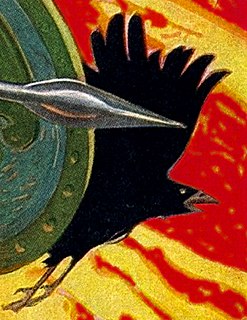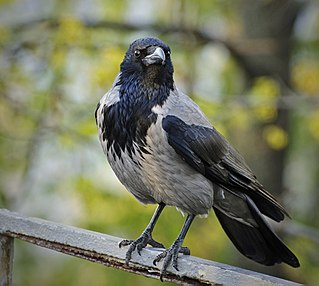Related Research Articles

Excalibur is the legendary sword of King Arthur, sometimes also attributed with magical powers or associated with the rightful sovereignty of Britain. Excalibur and the Sword in the Stone are sometimes said to be the same weapon, but in most versions they are considered separate. Excalibur was associated with the Arthurian legend very early on. In Welsh, it is called Caledfwlch; in Cornish, Calesvol ; in Breton, Kaledvoulc'h; and in Latin, Caliburnus.

Lugh or Lug is one of the most prominent gods in Irish mythology. A member of the Tuatha Dé Danann, Lugh is portrayed as a warrior, a king, a master craftsman and a savior. He is associated with skill and mastery in multiple disciplines, including the arts. He is also associated with oaths, truth and the law, and therefore with rightful kingship. Lugh is linked with the harvest festival of Lughnasadh, which bears his name. His most common epithets are Lámfada and Samildánach.

The Morrígan or Mórrígan, also known as Morrígu, is a figure from Irish mythology. The name is Mór-Ríoghain in Modern Irish, and it has been translated as "great queen" or "phantom queen".

The Tuath(a) Dé Danann, also known by the earlier name Tuath Dé, are a supernatural race in Irish mythology. They are thought to represent the main deities of pre-Christian Gaelic Ireland. The Tuatha Dé Danann constitute a pantheon whose attributes appeared in a number of forms throughout the Celtic world.
The Dagda is an important god in Irish mythology. One of the Tuatha Dé Danann, the Dagda is portrayed as a father-figure, king, and druid. He is associated with fertility, agriculture, manliness and strength, as well as magic, druidry and wisdom. He can control life and death, the weather and crops, as well as time and the seasons.
Conn Cétchathach, son of Fedlimid Rechtmar, was, according to medieval Irish legendary and annalistic sources, a High King of Ireland, and the ancestor of the Connachta, and, through his descendant Niall Noígiallach, the Uí Néill dynasties, which dominated Ireland in the early Middle Ages, and their descendants.
Art mac Cuinn, also known as Art Óenfer, was, according to medieval Irish legend and historical tradition, a High King of Ireland.

In Irish mythology, the Badb, or in Modern Irish Badhbh —also meaning "crow"—is a war goddess who takes the form of a crow, and is thus sometimes known as Badb Catha. She is known to cause fear and confusion among soldiers to move the tide of battle to her favoured side. Badb may also appear prior to a battle to foreshadow the extent of the carnage to come, or to predict the death of a notable person. She would sometimes do this through wailing cries, leading to comparisons with the bean-sídhe (banshee).
In Irish mythology, Elatha, Elotha, Elier or Elada was a king of the Fomorians and the father of Bres by Ériu of the Tuatha Dé Danann, as well as Delbaeth, Ogma, Elloth, and the Dagda by an unnamed mother. The imagery surrounding him suggests he may once have been a sun or moon god.

The Fomorians are a supernatural race in Irish mythology. They are often portrayed as hostile and monstrous beings who come from under the sea or the earth. Later, they were portrayed as giants and sea raiders. They are enemies of Ireland's first settlers and opponents of the Tuatha Dé Danann, the other supernatural race in Irish mythology. However, their relationship with the Tuath Dé is complex and some of their members intermarry and have children. The Fomorians have thus been likened to the jötnar of Norse mythology.

Cú Chulainn, also spelled Cú Chulaind or Cúchulainn and sometimes known in English as Cuhullin, is an Irish mythological demigod who appears in the stories of the Ulster Cycle, as well as in Scottish and Manx mythology. He is believed to be an incarnation of the Irish god Lugh, who is also his father. His mother is the mortal Deichtine, sister of Conchobar mac Nessa.
Ogma is a god from Irish and Scottish mythology. A member of the Tuatha Dé Danann, he is often considered a deity and may be related to the Gallic god Ogmios. According to the Ogam Tract, he is the inventor of Ogham, the script in which Irish Gaelic was first written.

Aífe is a character from the Ulster Cycle of Irish mythology. She appears in the sagas Tochmarc Emire and Aided Óenfhir Aífe. In Tochmarc Emire she lives east of a land called Alpi, usually understood to mean Alba (Scotland), where she is at war with a rival woman warrior, Scáthach. In Aided Óenfhir Aífe she lives in Letha, and is Scáthach's sister as well as rival – they are both daughters of Árd-Greimne of Lethra.
Connla or Conlaoch is a character in the Ulster Cycle of Irish mythology, the son of the Ulster champion Cú Chulainn and the Scottish warrior woman Aífe. He was raised alone by his mother in Scotland. He appears in the story Aided Óenfhir Aífe, a pre-tale to the great epic Táin Bó Cúailnge.

A Feast for Crows is the fourth of seven planned novels in the epic fantasy series A Song of Ice and Fire by American author George R. R. Martin. The novel was first published on October 17, 2005, in the United Kingdom, with a United States edition following on November 8, 2005.

Cath Maige Tuired is the name of two saga texts of the Mythological Cycle of Irish mythology. It refers to two separate battles in Connacht: the first in the territory of Conmhaícne Cúile Tuireadh near Cong, County Mayo, the second near Lough Arrow in County Sligo. The two texts tell of battles fought by the Tuatha Dé Danann, the first against the Fir Bolg, and the second against the Fomorians.

Táin Bó Flidhais, also known as the Mayo Táin, is a tale from the Ulster Cycle of early Irish literature. It is one of a group of works known as Táin Bó, or "cattle raid" stories, the best known of which is Táin Bó Cúailnge. Táin Bó Flidhais survives in two forms, a short version from the Old Irish period and a longer version found in the 15th century Glenmasan manuscript, which is held in the Advocates Library in Edinburgh. It is believed to be a copy of an earlier manuscript from the 12th century. The early version of Táin Bó Flidhais predates the Táin Bó Cúailnge. It is named for the heroine of the tale, Flidais.

The Crow War, also known as the Crow Rebellion, or the Crow Uprising, was the only armed conflict between the United States and the Crow tribe of Montana, and the last Indian War fought in the state. In September 1887 the young medicine man Wraps-Up-His-Tail, or Sword Bearer, led a small group of warriors in a raid against a group of Blackfoot which had captured horses from the Crow reservation. Following the raid, Sword Bearer led his group back to the Crow Agency to inform the Indian agent of his victory, but an incident arose which ended with the young leader taking his followers into the mountains. In response, the United States Army launched a successful campaign to bring the Crow back to the reservation.
Echtra Condla, ["The adventure of Conle"] is an Old Irish echtra tale known in two variants from eight manuscripts, the earliest of which has been dated to the 12th C.. - the tale may have been written down first as early as the 8th C. The two variants do not diverge sharply from one another, so that a single summary suffices for both.
References
| This article relating to a European folklore is a stub. You can help Wikipedia by expanding it. |
- ↑ Cross, Tom P. (1936). "The Adventures of Connla the Fair". Ancient Irish Tales. Henry Holt & Co. Retrieved 1 May 2013.
A woeful seat where Connla sits! Among short-lived mortals, Awaiting only dreadful death. The living, the immortal call to you; They summon you to the people of Tethra
- ↑ McCullough, David W. (2010). Wars of the Irish Kings: A Thousand Years of Struggle, from the Age of Myth Through the Reign of Queen Elizabeth. Random House Digital, Inc. p. 18. ISBN 978-0609809075.
Now in that battle, Ogma the champion found Orna, the sword of Tethra, king of the Fomoire. Ogma unsheathed the sword and cleaned it. Then the sword told what had been done by it, because it was the habit of swords at the time to recount the deeds that had been done by them whenever they were unsheathed.
- ↑ Julius Pokorny: 1079. Cf. also "Archived copy". Archived from the original on 2006-02-11. Retrieved 2006-02-11.CS1 maint: archived copy as title (link).
- ↑ "In Dúil Bélrai - Old Irish Glossary" . Retrieved 2019-03-11.